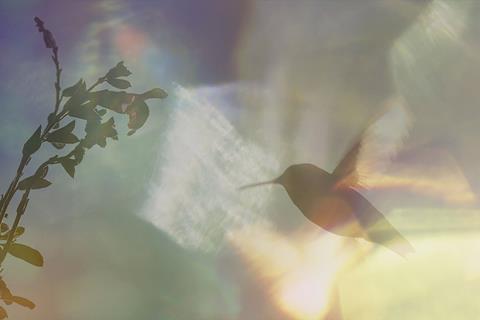Sally Aitken follows one woman’s tireless work caring for LA’s hummingbird population

Dir/scr: Sally Aitken. Australia. 2024. 93mins.
The hummingbirds of Los Angeles are tiny, impossibly fragile little creatures, barely bigger than a bumble bee, with bright, pinhead eyes and needle-thin beaks. But they punch above their weight as far as Terry Masear is concerned. Masear, the author of the bestselling memoir ’Fastest Things On Wings’, has dedicated her life to the rehabilitation of hummingbirds in need of help and she is a dream of a documentary subject; warm, knowledgeable and slightly eccentric. But the stars of the film are undoubtedly the birds, spectacularly captured with slow-motion macro photography to breathtaking effect.
The stars of the film are undoubtedly the birds
There’s a clear parallel here between this film, which comes to CPH:DOX following berths in Sundance, SXSW and Thessaloniki, and director Sally Aitken’s previous picture, Playing with Sharks: The Valerie Taylor Story. Both feature a Nat Geo-friendly combination of stunning wildlife photography and driven, passionate women committed to spreading their message about a particular creature. The gorgeous photography here – birds seem to hang unfeasibly in the air, making defiant eye contact with the camera – repays a big screen viewing. Yet the life-affirming themes of the film (Masear’s selflessness and empathy, the urge to make a positive difference one small bird at a time) could work equally well in a streaming release.
It is a subject that could tip over into saccharine sentimentality – and at times, the film comes close to doing so. The score can be a little arch, and details like the nests crocheted by volunteers (unpaid, according to one knitter, not because they are worthless but because they are priceless) feel almost aggressively cosy. But sentimentality is a luxury that a hummingbird rescuer can rarely afford.
Masear knows these minuscule birds to be warriors, clowns, stunt flyers and ruthless competitors for resources, and she estimates that she has fielded over 20,000 calls to her hummingbird hotline over the eighteen or so years that she has operated her rescue scheme. She gives names to the birds that are brought to her for care – we meet a pair of thimble-sized chicks christened the Sidney twins (named after the rescuer who drops them off); Cactus, called after the plant spines that injured her; SugarBaby, whose feathers were coated in sugar solution; and Raisin, among others. Not all survive. Masear solemnly buries each paper-light corpse, along with a tree flower. She tries, she says, not to get too attached to a bird that is unlikely to survive, but each failure cuts deeply.
The film raises certain questions: Who is this woman? Where does she get her tireless sense of purpose? How does she fund this all-consuming bird rescue operation which, during the spring and the summer, seems to take up every waking hour? Not everything is answered, but the film respectfully leads Masear through some personal details of extreme childhood abuse, something that she still clearly finds it hard to talk about.
Happier memories are revisited when Masear recalls her marriage to her late husband Frank, who, she feels, is present with her in spirit as she goes about the business of coaxing the bruised and broken birds back to life. And if the home-spun bird-based wisdom starts to get a little repetitive, the thrill of watching extraordinary footage of these shimmering, iridescent, physics-defying birds never grows old.
Production company: WildBear Entertainment, Dogwoof
International sales: Dogwoof sales@dogwoof.com
Producers: Bettina Dalton, Oli Harbottle, Anna Godas
Cinematography: Nathan Barlow, Dan Freene, Ann Prum
Editing: Tania Nehme
Music: Caitlin Yeo






![The Brightest SunScreen[Courtesy HKIFF]](https://d1nslcd7m2225b.cloudfront.net/Pictures/274x183/3/5/0/1448350_thebrightestsunscreencourtesyhkiff_312678.jpg)















![The Brightest SunScreen[Courtesy HKIFF]](https://d1nslcd7m2225b.cloudfront.net/Pictures/100x67/3/5/0/1448350_thebrightestsunscreencourtesyhkiff_312678.jpg)

